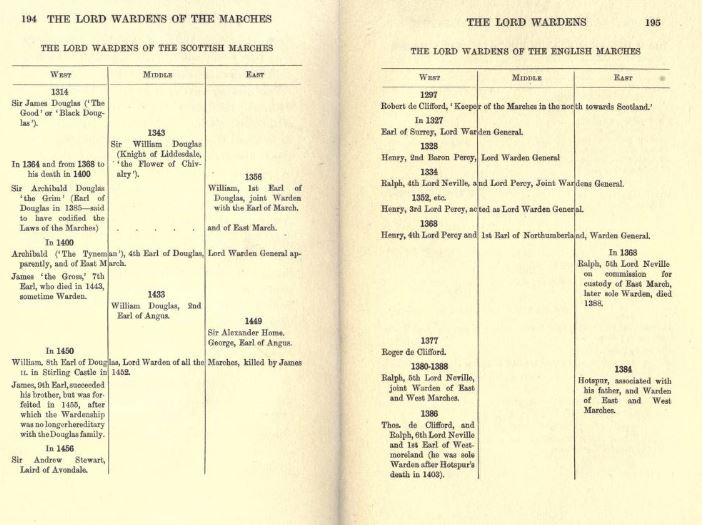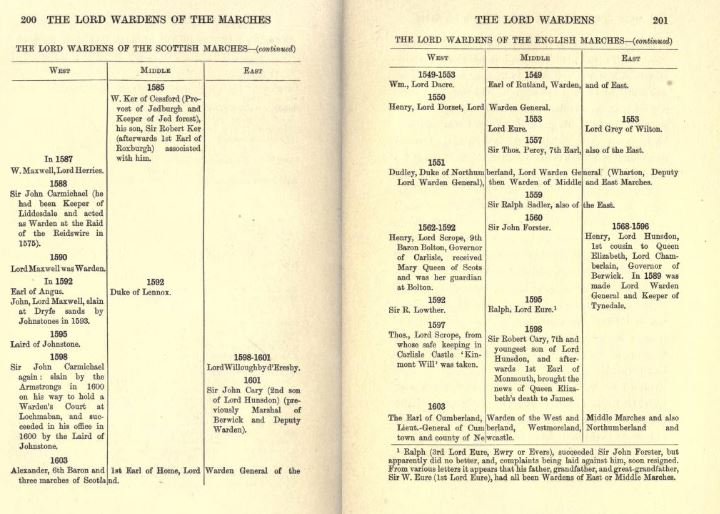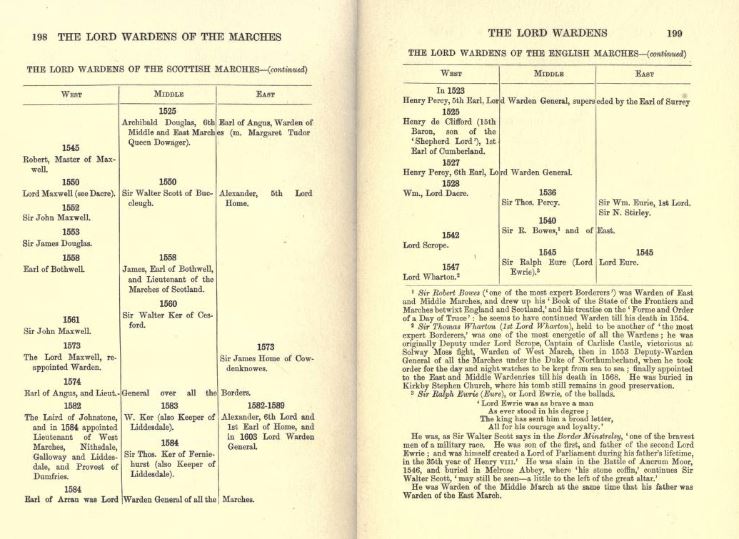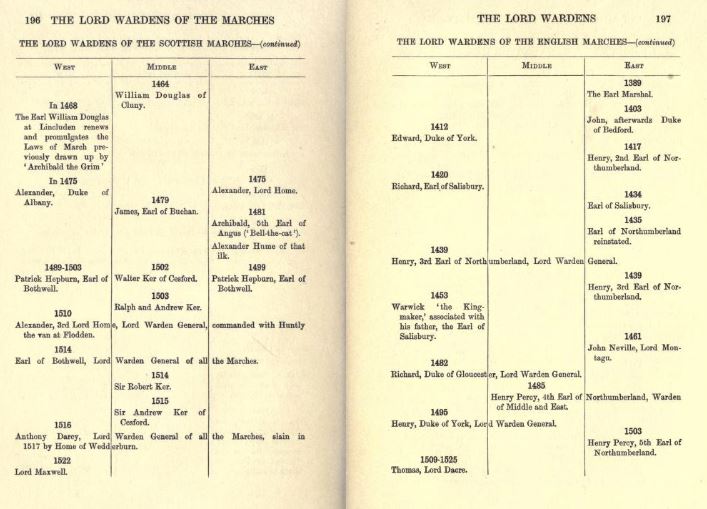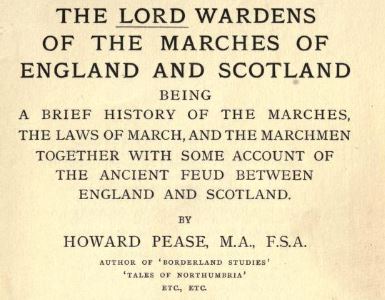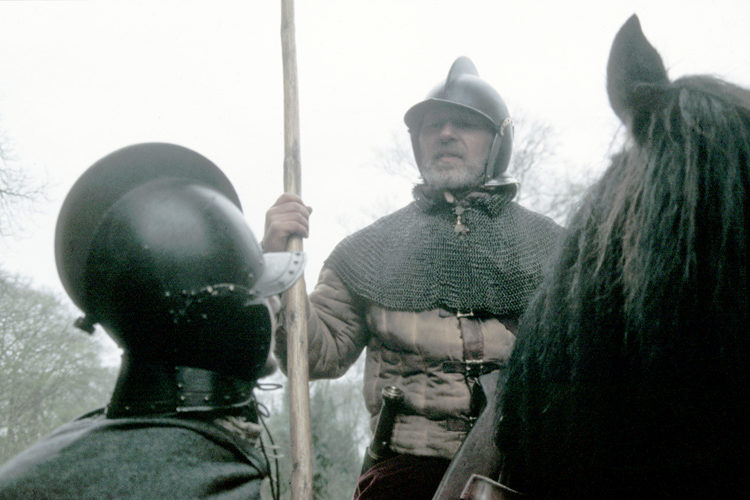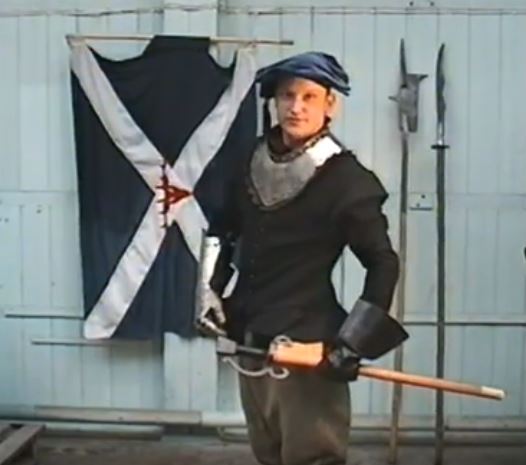The 'Peaceful Persuasion' And Transplanting Of The Marchmen By James VI Scotland & I England/Scotland…
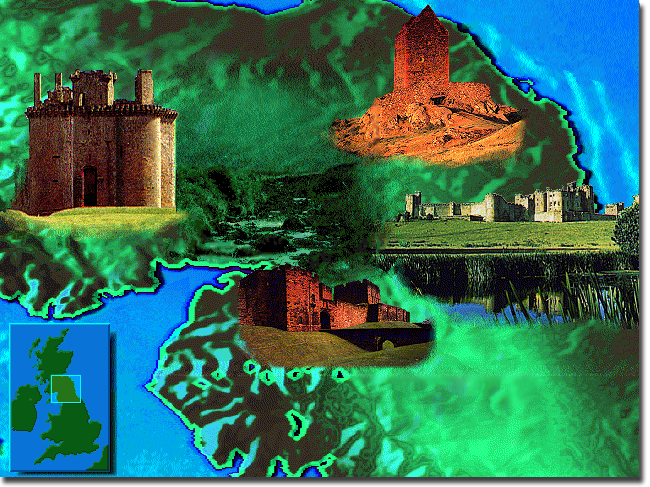
Wardens of The Marches
Wardens were appointed by the respective sovereigns of England and Scotland to govern the affairs of the Marches of the Border. The frontier was divided into three Marches on each side of the Border, each with a Warden to administer the Border laws and resolve disputes with his opposite number.
The Scottish Wardens were ill-paid and like the English office the Wardenship was not coveted as, due to the expense incurred, it was unprofitable. The fee for the West March, that “great and cummersome office”, had to be raised in order to get anyone to accept it.
In the second half of the 16th century the Wardenship of the East March of Scotland was in the hands of the powerful Hume family. In the Scots Middle March the office was in the hands of the Ker family of Fernieherst and Cessford. The Wardenship of the turbulent Scots West March in the later years of the 16th century was contested between the Maxwell and Johnstone families. The office of Warden of the English West March in Elizabeth I’s reign was held first by Lord Dacre then until almost the end of the century by Lord Scroope.
In the Middle March probably the most famous of the Wardens were Sir John Forster and Sir Robert Carey. In the East March, Lord Hunsdon and his sons Robert and John Carey all held the Wardenship with distinction.
Wardens – Guardians of The Marches
See The Lord Wardens Of The Marches Of England And Scotland by Howard Pease. Limited to 500 copies. Published 1912. Wp48
On the English Border there would be the garrison at Berwick-on-Tweed under the control of the Lord Warden, with a captain at Norham Castle and Wark as aides; to him the inhabitants on the southern side would owe Border service as far as the Hanging Stone on Cheviot.
The Middle March had its separate Warden, who would reside possibly at Alnwick, as Sir John Forster, or at Harbottle Castle, as Sir Robert Carey, and who was responsible for that great extent of country which took in the remaining portion of Northumberland.
His Deputy would probably reside at his own house, as did Sir Cuthbert Collingwood at Eslington, who was for ever at enmity with his chief, Sir John Forster, who held the middle Wardenship so long in the reign of Queen Elizabeth.
Acting also under the Warden of the Middle March would be the Keeper of Tynedale, often a Heron of Chipchase Castle (as was the Sir John who was slain at the Reidswire in 1575, on occasion of the famous Warden’s meeting there), and the Keeper of Redesdale, a Hall sometimes or a Reed, as the ‘ Percy Reed for instance, of the well-known ballad who was murdered for the due discharge of his duty by the Croziers and the Halls, who held him at ‘ deadly feud.’
At Carlisle the Lord Warden of the Western March usually resided in the castle, though Lord Scrope in 1577 was in residence at Rose Castle, while the great ‘ Lord Dacre of the North,’ in the time of Henry vin. , dwelt at his castle of Naworth. Acting with him along the Western March would be his Deputy, sometimes a Lowther, whose duty it would be to keep the fortress of Rockliffe and protect the embouchures of Esk and Eden, together with his Constable, and the Stewards and Bailiffs of various Baronies, the Captain of Bewcastle, who was appointed by the Crown, and resided with a garrison at Bewcastle Castle, whose duty especially it was to stay the men of Liddesdale from raiding into England across ‘ the waste.’ Wp49
The Scottish East Warden was usually a Hume, residing generally in Hume Castle ;
The Scottish Middle Warden was generally a Ker, whether of Cessford or Ferniehirst, who frequently also held the Provostship of Jedburgh ;
The Scottish Western Warden was as a rule a Johnstone or a Maxwell, residing at Loch wood Tower, or Lochmaben, or Caerlaverock Castle respectively. He would seem also to have had control over Nithsdale, and Galloway, and the west part of Teviotdale, and on occasion he appears to have held therewith the Provostship of Dumfries.
The Keepership of Liddersdale
Liddesdale was generally included in the Middle March but owing probably to its always having been a distinct lordship and also on account of the extreme lawlessness of its inhabitants, it was during the greater part of the sixteenth century a separate charge, under the rule of a Keeper specially appointed by the Crown.(History of Liddesdale. (Douglas. Edinburgh, 1883.)
In the first instance, Liddesdale was ruled by the Douglas as hereditary Wardens of the West March ; later, when the Keepership was instituted, a Deputy was appointed, who seems ex officio to have been Captain of Hermitage Castle.
When the Keepership of Liddesdale had become a separate charge, the Lords of Liddesdale were often Keepers, as e.g. the Bothwells. Thus Patrick, Earl of Bothwell, was Keeper in 1528 ; James, Earl of Bothwell, also was Keeper, and resided in Hermitage, where, when he lay wounded, Queen Mary rode over from Jedburgh to see him. His nephew and successor, Francis, likewise served in this office. Finally Buccleugh, first Lord Scott, was appointed Keeper by James VI. and allowed rank as Warden.
It was always very difficult to get justice done for Liddesdale, since the fierce Elliots and Armstrongs dwelling within their ‘ swyres ‘ were as a byke of hornets, and apparently from the following letter of Scrope’s clerk under eight successive Keeperships no meeting had been held with the English Warden of the West March. ‘ All theise underwritten as is credible enformed, have ben Keepers of Lyddesdaile successyvelie, of whom their is nether recorde nor memorie so far as I can learne, for any meetinge for redres with any the Wardens of the West March as Gamelpeth for Lyddesdaill. The Lorde Burthick, the Erie Bothwell, the Larde of Cawdor, the Larde Trachguars, the Tutor of Petcurr, Mr. Mychell Bow- flower, the Lorde Herries, the Larde of Carminghell.’
Officers of the Warden
Each Warden had his various officers, such as Land Serjeants and Water Serjeants (who apprehended delinquents and carried instructions), clerks to keep the Warden Courts, Setters and Searchers of the Watches by the Fords, and lastly his company or bodyguard of relatives, and those ‘ young bloods ‘ of the Border who wished for the excitement and experience of fight or raid.
Some further particulars may here be given of the various other Keeperships on the Scots and English Borders which were subordinate to the Wardenries, as, for example, in the English Middle March Tynedale and Redesdale, and in the Scots Western March Annandale, the Keepership of which was in the hands of the Captain of Langholm, 1 ‘ who lyeth with a charge at the Castle of Langam.’
‘ This captaine lyeth with a charge att the Castle of Langam, yf there be any breache or great rydinge in Scotland by English Borderers. And he is called the Keeper of Annandale : his service opposite against Beucastle, Eske and Leven or Bourgh at some tymes.’ (‘ Musgrave’s Report to Burghley,’ Calendar of Border Papers.) Wp51
In Annandale, indeed, as one gathers from the orders given in Appendix, No. 11, of the Leges Marchiarum, there were various ‘ Warden deputies/ for the House of Annand was to be ‘ keeped with ane honest man and wise, and he to be Warden Deputy, and to hold with him xvi well-horsed men, and the men to be called the Household : for their sustentation every one of them to have 100 m, 4 nithsdale bolls of horse-come.’
Further, it is ordered in regard to the keeping of the House of Lochmaben that it ‘ be keeped by ane wise and famous gentleman, and he to have with him five well-horsed men, and to be Stewart Deputy/ and also that ‘ the Lairds of Howmaines and Newbie be over the Helpers, Assisters, and maintainers of them.’
Further, the House of Howdam (Hoddam in Annandale) was ‘ to be keeped with ane wise Stout man, and to have with him four well-horsed men, and these to have 2 stark footmen servants to keep their horses, and the principal to have ane stout footman. . . .’
The continual unrest and the constant thievery in Annandale can be easily gauged by the appointment of these various officers, Stewart-deputes, Warden- deputes, Constables, Chamberlains and Captains.
On the English Border also we read of various subordinate officers, such as Constables, Land Ser- jeants and Captains. These Land Serjeants were the Warden’s officers, whose chief duty seems to have been to apprehend thieves and fugitives in readiness for a Warden’s Court or ‘ Day of March,’ while the ‘ Water Keepers/ Water Bailiffs and Water Serjeants were bound to keep the ‘ entrance of all men without lycence out of either marche/ and had ‘libertie at all tymes to enter the marches without licence, and to carry messages or letters betwixt the Wardens.
In the case of the Land Serjeant of Gilsland, however, of whom frequent mention is made, more important duties were attached to this particular office. Originally he seems to have been Chief Steward or Bailiff to the Lord of Gilsland, but when Queen Elizabeth took away from Lord William Howard and his wife (Lady Elizabeth Dacre 1 ‘ Bessie wi’ the braid apron’) the baronies of Burgh, Graystock and Gilsland, it was urged that Gilsland should be put upon the same footing as Bewcastle captaincy, which was a Crown appointment.
1 ‘ Ultimately in 1601, the Queen permitted the sisters (the Ladies Dacre, co-heiresses of the last Lord Dacre, who had been married to the Earl of Arundel and Lord William Howard, respectively), to buy back their lands by a payment of some 10,000 each, and the long lawsuit was ended to the profit of the royal coffers.’ Wp53
The following account of the Land Serjeants of Gilsland is taken from Thomas Carleton’s report thereon in 1577 to Lord Burghley. (Calendar of Border Papers.)
‘ The Land Serjeaunt, then but a particular servaunt to the Lord Dacre, having in his absence the commaund and government of that whole barony of Gilsland, having for his maintenance the better to discharge that government, his chamber, stable, horse- meat, allowance for his men, all the Lord’s household servaunts, allwayes at the fewest 24 or 30, able and well-horsed men, at his call and commaundement. The land serjeaunt his dew fee for that office only five pounds, and his lord and masters countenannce, which was more than all the rest.’ Apparently he (Thomas Carleton, Land Serjeant) lived at Askerton, ‘ a house of good strength and defence, and the only house in Gilsland fit for the land Serjeant to dwell in.’ (Border Papers, vol. ii. p. 575.)
As for the Captaincy of Bewcastle, we quote the following from the auditor’s report to Cecil in Queen Elizabeth’s reign. ‘ Her Majesty in her 32nd year, granted to Sir Simon Musgrave Knight, and Thomas Musgrave his son for the term of their 2 lives, Plumpton Park, with all rents, etc., being 168, 7s. Od. per annum absque compoto seu aliquo inde reddendo. And, as I take it, they have moreover as incident and belonging to the said office of Captain of Bewcastle, all the rentes, demeane landes and tithes of Bewcastle, which I have hard to be better worth than 100 a year.’
An incomplete List of Wardens, 1558-1603. See images
The following is not a complete list of Wardens and it taken from “The Lord Wardens Of The Marches Of England And Scotland Being A Brief History Of The Marches, The Laws Of March, And The March Men Together With Some Account Of The Ancient Feud Between England And Scotland. By Howard Pease, M.A., F.S.A”
THE EAST MARCHES OF ENGLAND
1558 THOMAS, 7TH EARL OF NORTHUMBERLAND (1528-72)
He was Warden under Mary and was kept in office by Elizabeth, his patent being granted on January 18, anno I (1)
On November 8, 1559, he went to London, leaving Sadler to act in his absence, as his deputy. Sadler received no patent.2
1559 WILLIAM, 13TH BARON GREY DE WILTON (?—i 562)
His patent was granted on December 22, 1559.3
Sadler had charge of the East and Middle Marches during Grey’s absence in Scotland. Grey was only resident for a short time and then made efforts to resign. He died early in the morning of December 15, 1562, in the south.4
During the vacancy Sir John Selby acted as Warden, and Sir Thomas Dacre as Governor of Berwick. (10)
1563 FRANCIS, 2ND EARL OF BEDFORD (1 527—85)
He was appointed about November 20, 1563, and his patent was granted on February 24, I 564. He was recalled on October 9, 1567, and left Berwick on October 27, 1567.6
Sir William Drury, the Marshal, took charge of Berwick and the East Marches during the vacancy.7
15 HENRY, 1ST BARON HUNSDON (1524?—96)
His patents as Captain of Berwick and Warden were granted on August 25 and 26, 1568.8 He was absent from his charge for many years towards the end of his life, and died in the south on July 23, 1596.9
During the vacancy Sir R. Carey had charge of the East March and his brother, John, of Berwick. (10)
